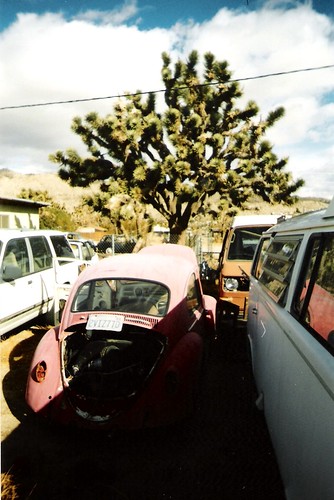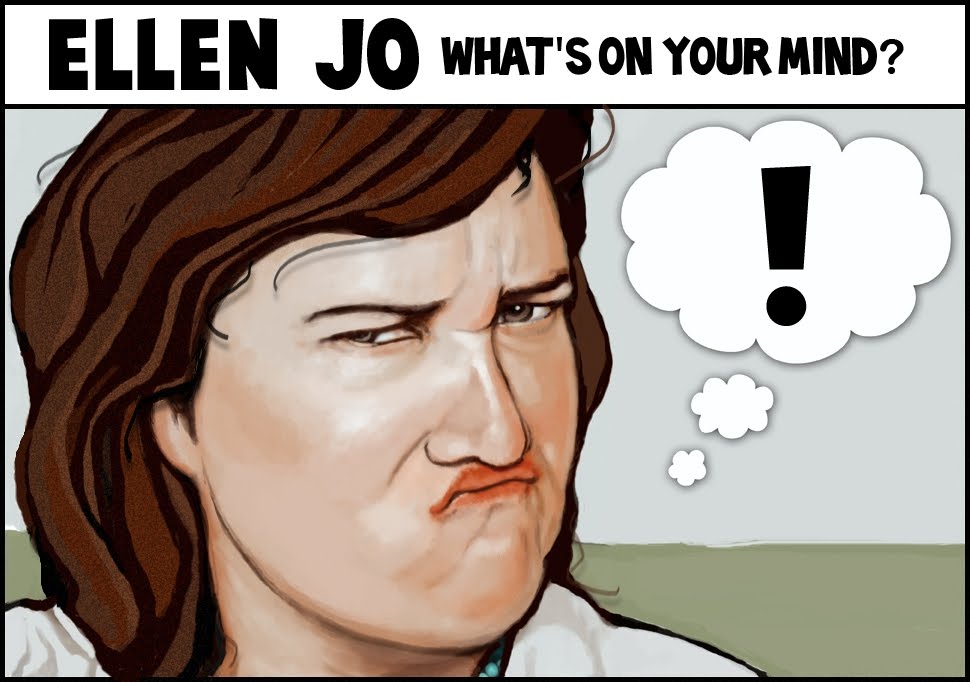California Desert Redux
April 2007- The Outs
Ellen Jo Roberts

Joshua Tree. It was our very first Karmann Ghia road trip, 8 years ago, and now it was looking like it would also be our last. Driving such an old car you must always be prepared for anything.
I don’t really know how we ended up sitting on the ground in front of French’s Vintage Volkswagen Parts & Repair in Yucca Valley, California. Thank God such a place existed, with its racks full of Volkswagen parts and back-lot graveyard of VW ghosts.

We sat there for five hours while a brash young feller worked on our car so we could get back on the road home. Electrical problems. Faulty ignition. Intermittent sputtering. Five hundred miles done, 325 left to go. The sky fluctuated between sun and rain. The grove of Joshua Trees in the distance added to the surreal scene. Sometimes we’d go inside and chat with the old hippies and greasers at the front counter as they took long drags on their cigs.

When you own a vintage Volkswagen you are instantly member of a tribe, a subculture of sorts. Somehow the idea that we might be truly stranded in this blasted stretch of Mojave Desert didn’t even upset me. I had miraculously transcended the anxiety caused by an ill-running automobile. (Note: years of practice had led up to this moment). A strange sort of calm. This was an authentic experience, and we were meeting real people. We were getting down and dirty, down to the nitty gritty.
Those people in their modern minivans, with their air conditioning and DVD players didn’t know what they were missing. They drove past us on Hwy 62 like we didn’t even exist.

Last time we went to Joshua Tree National Park was 1999, an inaugural road trip taken in a recently purchased 1973 Karmann Ghia. Now many miles and many road trips since, we had been hankering to return. Joshua Tree National Park is a jewel in the crown of the National Park Service - a vast forest of Joshua Trees (a member of the lily family, closely related to the yucca) and gigantic granite boulders covering the landscape in big molten lumps. It was a favorite spot and we were going back to it.
The Ghia, with its new tires, new clutch, fresh oil seemed the most sturdy choice from our stable of vintage junkola. But I don’t ever kid myself. It’s always risky. We packed it full of camping gear, clothing, picnic items, dogs, and shoehorned 6’4’’ Chad into the passenger seat for the nearly 400-mile trip to Twenty-Nine Palms, California.
Mapquest advised taking the interstates, but we disregarded the Internet and headed through Jerome and over Mingus on 89A, Hwy. 89 out of Prescott through Yarnell, towards Salome. A gorgeous drive, smooth and lovely, dropping in elevation in big lazy curves. A lady at a Yarnell gas station came out and asked if were on a “road tour,” barely containing her fascination with our strange looking yellow car. She suggested we hook into nearby Hwy 71, to Hwy 60 to 72 and up to 62 across the Colorado River into California.
“To 29 Palms that’s the fastest way. Sure is.” And it sure was. It lopped about 90 miles off of those stupid Mapquest directions, though didn’t cut down too much on time, as the roads were all paced at a historic 50-55 mph. The roads less traveled.

Sailing along in the sunshine and dry desert breezes, we were starring in our very own movie, some hipster adventure on grainy film, only difference being we weren’t on a killing spree nor on the lam from the law. Listening to the Devotchka soundtrack of “Little Miss Sunshine” and following old railroad tracks, the windows down, the dogs asleep, the engine purring like a sewing machine.
Crossing into California onto Hwy 62, we noticed names and phrases written with rocks along the edges of the railroad embankment. Hundreds of names all created with rocks lined up into letters. Some were created with brightly painted rocks, but most were just the dark brown color of the ballast below the tracks. It went on for miles, sometimes stopping for stretches and starting back up again later.
The road was a lullaby, a roller coaster up and down through dips and vados.
What a glorious day. “I think this is my new favorite highway.”
We were the only ones out there.
Watching the gas tank dip below, we suddenly realized the road less traveled also had no gas stations. The needle dropped past “Reserve” and slowly crept far to the left, the farthest I’d ever seen it go. One hundred twenty miles with no service stations. The last 50 miles were spent with knuckles white and sphincters clamped tight in fear we’d sputter out alongside the road before reaching any civilization.
Thinking of a plan, how we’d do it, who’d we wave down. No cell phone. But we breezed into 29 Palms on fumes and a stiff tailwind, all the way from Clarkdale, Ariz. to 29 Palms, Calif. on just one 11-gallon tank of gas.
“This will have residual problems,” I said, as we exhaled deeply and filled the tank up, “I’m sure we sucked up lots of crud from the bottom of that old tank. Never had that tank so low.” We also wondered why our 1973 model car gets better gas mileage than most other cars on the road today. Seems pretty backwards. Seems we could be driving solar powered hovercrafts by now.
Joshua Tree National Park wears a loose necklace of towns, ranging clockwise from Palm Springs, to Cabazon, Yucca Valley, Joshua Tree and 29 Palms. The entire area is engulfed in a postmodern cloak of “Googie” style architecture, so predominant in mid-century California. Motels and liquor stores feature “Populuxe” signs full of starbursts and arrows and wonderful fonts. Gas stations with outrageous cantilevered roofs swing out towards the heavens in extreme geometry.
First off, we headed west to Cabazon to visit some old friends. Two giant dinosaurs, “Dinny" (1964) and “Mr. Rex” (c.1981) famously watch over the “Wheel Inn” restaurant and from time to time appear in rock videos or Pee Wee Herman films. Guarding the windy entrance to the Coachella Valley, the Cabazon dinos are pop culture superstars and always worth a stop. The bodies of the beasts hold a gift shop and museum respectively. If you happen to go there tell ‘em “Large Marge” sent you.

After a campout and a brief jaunt through Palm Springs (no famous people were spotted, though we did see the intersection of Bob Hope & Frank Sinatra Boulevards) we began heading back east. An afternoon in the national park, followed by a night spent at a sleazy dive in the town of Joshua Tree: some old highway motel which looked far better on the Internet than it did in real life.
The car began acting up. Sputtering, cutting in and out, and finally not starting at all. Crud in the carburetor was of course the first suspect, but no, plenty of gas was flowing … it was more electrical. It was a mystery and we were in trouble, far from home. Joshua Tree, Calif. was dusty and windswept and slightly ominous. It was as if we’d been slapped hard across the face! We were not going to make it home as breezily as we had blown into town!
“Pee Wee Herman was here and so wuz Floyd. No sign of U2 or Gram Parsons’ ghost. Beautiful drive in on old Hwys 71,60, 72, 62. Like we were in a movie” — postcard I sent.
Original “alt-country” rocker and former Flying Burrito Brother, Gram Parsons, died of a morphine overdose in Joshua Tree, Calif. in September of 1973. Supposedly his ghost can be seen at some local motel in the form of a spooky white cat. A white cat dressed in a fantastic sequined western jumpsuit!
Last day there we got an early start — a push start to be exact — and headed back west to Yucca Valley. A local had informed us we could find a top-notch dune buggy/vintage VW shop to diagnose our issues.
Five hours and $570 later we began our 8-hour return drive home, estimating we’d pull in the driveway (if we were lucky) just shy of 10pm that night, back to work the next day. As I looked at the receipt from the mechanics and the bag of old parts they’d removed, I thought about printing up a t-shirt that said: “I went to California and all I got was this stinking bill for $570 and a bag full of electrical parts!”
The Cali boy had the machine timed and tuned to run best at full throttle, like a jet, about 80 mph, so we opted to return a different route, up to connect with the old 66 in Amboy and over to Interstate 40 East. Amboy, California is a postmodern ghost-town, famous for its iconic Rt. 66 “Roy’s Café and Motel” sign, created at the height of Googie style, circa 1959. The town is actually one of California’s oldest cities, dating from 1858, due to the valuable salt lake chloride beds that line the region, and thriving until the early 1970s when Interstate 40 completely bypassed the town.

Nowadays, it sits smack dab in the middle of nowhere, a remote Retro-Future relic and a curiosity for nostalgia hounds and Rt. 66 buffs. Amboy is about 60 miles worth of remote highway north of 29 Palms and another 40 miles until I-40. Roy’s Café and Motel dates from the 1930s and closed in 1995, though word is that it was purchased by the owner of a California restaurant franchise a couple of years ago, and plans are in the works to preserve, restore and reopen the place. Perhaps next time we pass through (in another 8 years) we’ll be able to check into Roy’s and rest our road-weary bones in Populuxe-style splendor.

The rest of the trip was a blur, boring interstate, setting sun, and snow. When you drive an aged, air-cooled Volkswagen 900 miles, every single mile makes its impact on you — the loud hum of the highway and the noisy engine, the windows down, the wind in your ears and dust in your eyes. No hermetically-sealed modernity for us. We felt every bit of that road, we breathed every germ, we smelled every stink, and every sweetness.
We finally pulled into the driveway about 10pm, just as we suspected. Even though we had only been gone 3 days, it had seemed like an eternity. The house looked, and smelled wonderful. After a crazy trip like that, full of such trials and tribulations, nothing ever feels as good as your own bed. Completely exhausted, we fell into a slumber and dreamt of Joshua Trees, old motels and ghosts of Gram Parsons and Volkswagens past.
Ellen Jo Roberts lives in Clarkdale, Ariz. and likes to drive her Karmann Ghia to assorted far away places. All this hassle just so that she can take funny photos of her dogs. Read about it at www.ellenjo.com






